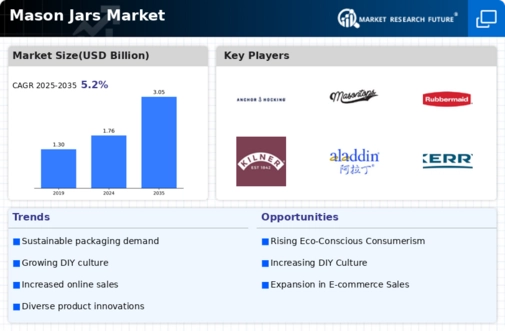Market Growth Projections
The Global Mason Jars Market Industry is poised for substantial growth, with projections indicating a market value of 1.76 USD Billion in 2024 and an anticipated increase to 3.05 USD Billion by 2035. This growth reflects a compound annual growth rate (CAGR) of 5.13% from 2025 to 2035. Such figures underscore the increasing popularity of Mason jars across various sectors, driven by trends in sustainability, home canning, and e-commerce. The market's expansion is indicative of broader consumer shifts towards reusable and multifunctional products, positioning Mason jars as a staple in modern households.
Health and Wellness Trends
The Global Mason Jars Market Industry is positively impacted by the rising health and wellness trends among consumers. As individuals become more health-conscious, they seek ways to store and prepare nutritious meals at home. Mason jars serve as an ideal solution for meal prep, portion control, and on-the-go consumption. This trend aligns with the increasing popularity of healthy eating habits, which is likely to drive demand for Mason jars. The market's growth trajectory suggests that as more consumers prioritize health and wellness, the Mason jar industry will continue to thrive, adapting to evolving consumer preferences.
Expansion of E-commerce Platforms
The Global Mason Jars Market Industry is significantly influenced by the expansion of e-commerce platforms. Online retailing provides consumers with convenient access to a wide variety of Mason jar products, including specialty and custom designs. This accessibility is particularly appealing to younger demographics who prefer shopping online. As e-commerce continues to grow, it is expected to contribute to the market's expansion, with projections indicating a market value of 3.05 USD Billion by 2035. The ease of purchasing Mason jars online enhances consumer engagement and drives sales, further solidifying the industry's position in the global market.
Rise of Home Canning and Preserving
The Global Mason Jars Market Industry benefits from the resurgence of home canning and preserving activities. This trend appears to be fueled by a growing interest in self-sufficiency and the desire for homemade food products. As individuals seek to control ingredients and reduce food waste, the demand for Mason jars increases. The market's projected growth rate of 5.13% CAGR from 2025 to 2035 suggests that this trend will likely persist, as more consumers embrace home canning as a viable alternative to store-bought options, thereby enhancing the market's overall value.
Diverse Applications Across Industries
The Global Mason Jars Market Industry is characterized by diverse applications across various sectors, including food and beverage, crafts, and home decor. Mason jars are utilized not only for food storage but also for creative projects, gifting, and event decor. This versatility appeals to a broad consumer base, thereby expanding market reach. As industries continue to innovate and explore new uses for Mason jars, the market is likely to see sustained growth. The increasing recognition of Mason jars as multifunctional products may further enhance their appeal, contributing to the overall market dynamics.
Growing Demand for Sustainable Packaging
The Global Mason Jars Market Industry experiences a notable increase in demand for sustainable packaging solutions. As consumers become more environmentally conscious, they gravitate towards reusable and recyclable products. Mason jars, known for their durability and versatility, align well with this trend. In 2024, the market is valued at approximately 1.76 USD Billion, reflecting a shift towards eco-friendly alternatives in packaging. This trend is likely to continue, as sustainability becomes a key consideration for consumers and manufacturers alike, potentially driving the market further as businesses adopt greener practices.





















